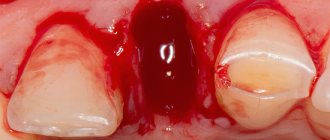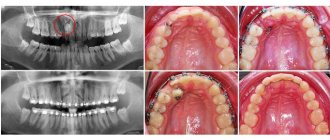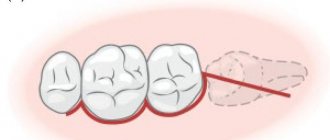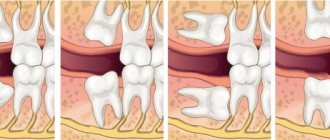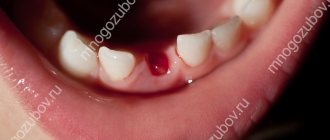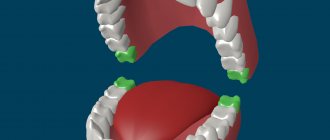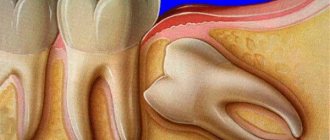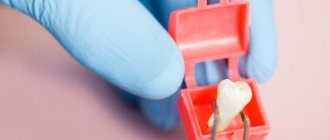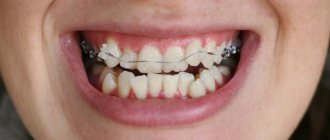Chief editor of the site:
Snitkovsky Arkady Alexandrovich
Chief physician of the professorial dentistry “22 Century”, dentist, orthopedic dentist
Author of the article:
Scientific team of dentistry “22 Century”
Dentists, candidates and doctors of medical sciences, professors
Removing wisdom teeth without pain is not a myth
Removing a wisdom tooth without pain is not a myth , since in Moscow, at the 22nd Century Professorial Dentistry Clinic, this operation is performed completely painlessly.
Anatomical and physiological features
Everyone knows that each person out of the total number (32) has 4 wisdom teeth. First, our milk teeth erupt, and then they are replaced by permanent ones, with which we live our whole lives. Only two couples are distinguished by their “unpunctuality” and are 18 years , or even more. In dentistry, they are usually called “eighth teeth.” Why do they, having received such an interesting name, often create a lot of trouble, and sometimes cause acute pain that can even bring an adult to tears? This is due to the fact that the gums in the place where the wisdom tooth should erupt are not prepared for this process, because there have never been baby teeth here.
No need to worry
Contact a clinic where an experienced dentist will evaluate your condition.
Let's clarify what should be done if wisdom teeth not only decide to appear, but their eruption is accompanied by excruciating pain . You should not expect the pain to go away on its own. Contact the clinic, where an experienced dentist will assess your condition, see how many wisdom teeth you have already erupted, and also tell you about their location. In practice, there are often cases when it is impossible to determine “by eye” whether the teeth are positioned correctly.
At the 22nd Century Professorial Dentistry Clinic, you will have a panoramic X-ray of your jaw, which will give you a complete visual picture. If the teeth are positioned correctly, then there may be no reason for surgery, but there may be a situation when, for example, removal of the lower and upper wisdom teeth is simply necessary. Each case is considered individually, taking into account all the nuances, and this is the key to successful treatment.
Preparing for removal
It is necessary to prepare for the removal of a wisdom tooth in the lower jaw. The procedure can only be carried out after a thorough examination of the structure of the tooth and its roots.
A panoramic photograph of the jaw allows you to evaluate the correct placement of wisdom teeth.
X-rays are required to determine the expected structure of the tooth root as accurately as possible. In the third molars (as wisdom teeth are called in medicine) of the lower jaw, only one root is extremely rarely formed. Most often these are three or four branches, curved at the most intricate angles. It is for this reason that removing the roots of the teeth of the lower jaw is a complex process, and without a picture it is unrealistic to predict the course of the operation. But all these are preparatory measures of the dental surgeon himself. The patient is required to take the following actions:
- It is best to plan wisdom tooth removal in the first half of the day. Firstly, your body still has enough energy resources to successfully survive the operation. Secondly, after anesthesia, severe pain almost always occurs, which you can cope with before going to bed at night.
- It is recommended to eat before surgery. There are several reasons for this. Endorphins released after eating help you relax. And your blood will clot somewhat faster than a person’s on an empty stomach. And you won’t be able to have a snack anytime soon.
- Before removing a wisdom tooth, you can take a mild sedative to calm you down. This will help you relieve nervousness and get into a positive frame of mind.
Important! In order to calm down, it is forbidden to drink alcohol, both before and after surgery. Alcoholic drinks have a thinning effect on the blood and promote vasodilation. This may cause severe bleeding during surgery.
To be afraid or not
We carry out operations to remove teeth of any complexity.
Even if the dentist concludes that extraction cannot be avoided, you should not be afraid of it. Fear can increase pain, and in addition, it lowers the threshold of pain sensitivity and even unpleasant sensations of moderate intensity can seem incredibly pronounced. Our clinic is not just a dental center where high-class professionals , because it is not for nothing that it is called professorial dentistry. We perform tooth extraction operations of any complexity, trying to minimize discomfort and consequences.
Removal process
Generally speaking, the removal of lower jaw teeth is carried out according to a standard procedure applicable to all teeth. This includes antiseptic treatment, anesthesia, grasping the tooth with forceps and removing it from the oral cavity. But there are some nuances due to the location and structure of the figure eight.
This image shows the process of wisdom tooth removal: administration of anesthesia - dissection of the gums - removal - suturing the wound.
Let's start with the fact that the procedure for extracting a wisdom tooth is performed using special forceps designed for operations on the lower jaw. And in case of an unerupted figure eight that needs to be removed, an initial incision in the gum is required, followed by its suturing after the third molar is extracted. In addition, the high bone density of the lower jaw does not make it possible to easily loosen and remove a tooth, as is the case with operations on the upper eights. And the lack of free space makes itself felt. And, of course, the structure of the tooth root. Simply pulling out the eight directly will not work. And with strong curls and bends in the root, it may be necessary to saw the tooth in half and then extract it in parts. Most often, an experienced dentist can predict such a development of the situation from the image and warn the patient in advance about the need for such manipulations. And when planning a complex removal, the issue of using drugs for general anesthesia is considered.
General or local anesthesia
The choice of anesthesia method is made jointly by a dental surgeon and an anesthesiologist.
Typically, the removal of the so-called “eight” occurs under local anesthesia after the dentist is sure that you do not have an allergic reaction to the painkiller used. Under general anesthesia, complex wisdom tooth removal occurs if the “object of your suffering” is located under the soft gum tissue, exerts strong pressure on neighboring teeth, or is significantly displaced towards the cheek. The choice of anesthesia method is made jointly by the dental surgeon and anesthesiologist .
Symptoms of improper eruption of lower wisdom teeth
Swelling of the tissues outside on the affected side
The range of symptoms for abnormal eruption of the lower “eight”:
- Pain, swelling, swelling of the gums.
- Putrid amber from the mouth, discomfort in the mouth.
- Earache.
- Pain, difficulty opening the mouth.
- Enlargement of the lymph node/lymph nodes of the submandibular region.
- Swelling and tension of the tissues outside on the affected side.
- Pain when swallowing.
These symptoms are expressed to a greater or lesser extent, all or several of them are present, which depends on the nature of the location and characteristics of tooth eruption. It is important whether inflammatory complications such as pericoronitis, periostitis, etc. are associated.
It is very important to remove teeth in the lower jaw in a timely manner, when the situation is not yet complicated by infection.
Care after tooth extraction and basic recommendations
Even despite the fact that in the 22nd Century clinic , operations to remove wisdom teeth are carried out with a negligible amount of trauma, during the day the patient may feel aching pain, and moderate swelling of the gums and surrounding tissues is also possible. This condition can be greatly alleviated by applying ice to the cheek or a pain reliever prescribed by a doctor. Healing will be much faster if the patient refuses physical activity, hot food and drinks.
It is also better to avoid intensive rinsing, and it is recommended to brush your teeth only the next day after surgery.
Consequences of wisdom tooth removal
Bleeding from the socket.
After removing the figure eight, the doctor uses a gauze swab to clean the removal site. Do not rush to take it out, even if it causes you discomfort. This tampon must be kept in the mouth for 20 minutes; for patients with arterial hypertension or simply poor blood clotting, it is advisable to leave it for 40-60 minutes. Otherwise, bleeding may resume. It is also better to refrain from rinsing the mouth to keep the clot in the hole, as this promotes more effective healing. An empty socket in the gum quickly becomes covered with food debris and plaque, becomes infected and inflamed.
Pain.
The most painful hours after removal are the first two hours, at which point the anesthesia wears off. In some particularly sensitive patients, mild pain may continue to be felt for several days. If you have severe pain, you can take an analgesic. This should be a drug that you already know is suitable for your body, or as prescribed by a doctor. For example: “Ketanov”, “Nurofen”, Ketorol”, etc.
Antibacterial drugs are prescribed only in cases where there has been an infection in the oral cavity or after an intervention there is a high risk of infection.
You can numb a wisdom tooth after removal with regular painkillers, such as ibuprofen. But don't rush to take the pill. Sometimes an ice pack helps relieve pain. If you still cannot do without medication, you can start with half a tablet.
If, even after taking the full dose indicated in the annotation, the pain does not go away for a long time and increases, you should consult a doctor: perhaps he will prescribe stronger drugs.
Cooling.
In general, using an ice pack after simple removal is not necessary. If the doctor recommended cold for you, then apply a cool compress through a thin cloth; such sessions can be carried out for no longer than 25 minutes. Carefully ensure that there is no severe hypothermia, since prolonged exposure to cold slows down healing and, on the contrary, can lead to increased pain.
Seams.
After surgery, your dentist may place stitches on the surgical area. Usually the sutures are removed no later than 7-8 days after removal. However, removal of sutures may not be necessary if, for example, catgut is used as a suture material. This material dissolves on its own within 10 days.
Cost of treatment at the professorial dental clinic “22 Century”
On our website you can quickly and easily find out the cost of all types of treatment, track new promotions and discounts, and also read reviews from our patients. The price of our services cannot be considered high or low; it can rightly be said that it is reasonable and affordable. In this case, the consultation with the head physician is absolutely free .
Date of publication: September 20, 2020 Last update: September 22, 2020 © 2020 Professorial Dentistry “22 Century”. All rights reserved.
